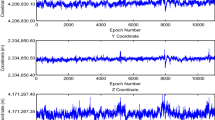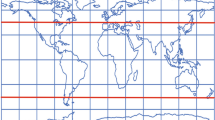Abstract
Error analysis in length measurements is an important problem in geographic information system and cartographic operations. The distance between two random points—i.e., the length of a random line segment—may be viewed as a nonlinear mapping of the coordinates of the two points. In real-world applications, an unbiased length statistic may be expected in high-precision contexts, but the variance of the unbiased statistic is of concern in assessing the quality. This paper suggesting the use of a k-order bias correction formula and a nonlinear error propagation approach to the distance equation provides a useful way to describe the length of a line. The study shows that the bias is determined by the relative precision of the random line segment, and that the use of the higher-order bias correction is only needed for short-distance applications.




Similar content being viewed by others
References
Biljecki F, Heuvelink GB, Ledoux H, Stoter J (2015) Propagation of positional error in 3D GIS: estimation of the solar irradiation of building roofs. Int J Geogr Inf Sci 29(12):2269–2294
Box M (1971) Bias in nonlinear estimation. J R Stat Soc Ser B (Methodological) 33(2):171–201
Chen W, Qin H (2012) New method for single epoch, single frequency land vehicle attitude determination using low-end GPS receiver. GPS Solut 16(3):329–338
Cook R, Tsai C-L, Wei B (1986) Bias in nonlinear regression. Biometrika 73(3):615–623
Fischer MM, Nijkamp P (1992) Geographic information systems and spatial analysis. Ann Reg Sci 26(1):3–17
Goodchild MF (1999) Measurement-based GIS. In: Shi WZ, Goodchild MF, Fisher PF (eds) Proceedings of the International Symposium on Spatial Data Quality ‘99. Hong Kong Polytechnic University, Hong Kong, pp 1–9
Goodchild MF (2004) A general framework for error analysis in measurement-based GIS. J Geogr Syst 6(4):323–324
Goodchild MF, Hunter GJ (1997) A simple positional accuracy measure for linear features. Int J Geogr Inf Sci 11(3):299–306
Heki K, Takahashi Y, Kondo T (1989) The baseline length changes of circumpacific VLBI networks and their bearing on global tectonics. IEEE Trans Instrum Meas 38(2):680–683
Heo J, Woo Kim J, Sang Park J, Sohn H-G (2008) New line accuracy assessment methodology using nonlinear least-squares estimation. J Surv Eng 134(1):13–20
Jeudy LMA (1988) First and second moments of non-linear least-squares estimators application to explicit least-square adjustments. Bull Geod 62(2):113–124
Kobayashi T, Miller HJ, Othman W (2011) Analytical methods for error propagation in planar space–time prisms. J Geogr Syst 13(4):327–354
Lawford GJ, Gordon I (2010) The effect of offset correlation on positional accuracy estimation for linear features. Int J Geogr Inf Sci 24(1):129–140
Leick A (2004) GPS Satellite Surveying. Wiley, Hoboken
Leung Y, Ma J-H, Goodchild MF (2004a) A general framework for error analysis in measurement-based GIS part 1: the basic measurement-error model and related concepts. J Geogr Syst 6(4):325–354
Leung Y, Ma J-H, Goodchild MF (2004b) A general framework for error analysis in measurement-based GIS part 2: the algebra-based probability model for point-in-polygon analysis. J Geogr Syst 6(4):355–379
Leung Y, Ma J-H, Goodchild MF (2004c) A general framework for error analysis in measurement-based GIS part 3: error analysis in intersections and overlays. J Geogr Syst 6(4):381–402
Leung Y, Ma J-H, Goodchild MF (2004d) A general framework for error analysis in measurement-based GIS part 4: error analysis in length and area measurements. J Geogr Syst 6(4):403–428
Mathai AM, Provost SB (1992) Quadratic Forms in Random Variables: Theory and Applications. M. Dekker, New York
Mitrovica J, Davis J, Shapiro I (1993) Constraining proposed combinations of ice history and Earth rheology using VLBI determined baseline length rates in North America. Geophys Res Lett 20(21):2387–2390
Mozas AT, Ariza FJ (2010) Methodology for positional quality control in cartography using linear features. Cartogr J 47(4):371–378
Nie Z, Wang Z, Ou Z, Ji S (2015) On the effect of linearization and approximation of nonlinear baseline length constraint for ambiguity resolution. Acta Geod Cartogr Sin 44(2):168–173
Ranacher P, Brunauer R, Trutschnig W, Van der Spek S, Reich S (2016) Why GPS makes distances bigger than they are. Int J Geogr Inf Sci 30(2):316–333
Seber GAF (2008) A Matrix Handbook for Statisticians. Wiley-Interscience, Hoboken
Spiegel MR (1968) Mathematical handbook of formulas and tables. Schaum’s outline series, McGraw-Hill, New York
Stanislawski LV, Dewitt BA, Shrestha RL (1996) Estimating positional accuracy of data layers within a GIS through error propagation. Photogram Eng Rem Sens 62(4):429–433
Teunissen PJG (1990) Nonlinear inversion of geodetic and geophysical data: Diagnosing nonlinearity. In: Brunner FK, Rizos C (eds) Developments in Four-Dimensional Geodesy. Springer, Berlin Heidelberg, pp 241–264
Teunissen PJG (2010) Integer last-squares theory for the GNSS compass. J Geodesy 84(7):433–447
Wheeler DC, Calder CA (2007) An assessment of coefficient accuracy in linear regression models with spatially varying coefficients. J Geogr Syst 9(2):145–166
Xue S, Yang Y (2014) Gauss–Jacobi combinatorial adjustment and its modification. Surv Rev 46(337):298–304
Xue S, Yang Y, Dang Y (2014) A closed-form of Newton method for solving over-determined pseudo-distance equations. J Geodesy 88(5):441–448
Xue J, Leung Y, Ma J-H (2015) High-order Taylor series expansion methods for error propagation in geographic information systems. J Geogr Syst 17(2):187–206
Xue S, Dang Y, Liu J, Mi J, Dong C, Cheng Y, Wang X, Wan J (2016) Bias estimation and correction for triangle-based surface area calculations. Int J Geogr Inf Sci 30(11):2155–2170
Zandbergen PA (2008) Positional accuracy of spatial data: non-normal distributions and a critique of the national standard for spatial data accuracy. Trans GIS 12(1):103–130
Acknowledgements
We would like to express many thanks to Prof. M.M. Fischer for his helpful comments. This work is supported by National Science Foundation of China (41020144004, 41104018, 41674014, and 41474011). National Key R&D Program (2016YFB0501700, B1503, 2009AA121405 and 2013AA122501) and GFZX0301040308-06.
Author information
Authors and Affiliations
Corresponding author
Appendix: k-Order approximation about the expectation of the length statistic
Appendix: k-Order approximation about the expectation of the length statistic
1.1 De-correlation on the variance matrix of the positional error
To simplify the discussion, the correlation between \( \varepsilon_{i} \) and \( \varepsilon_{j} \) of \( {\varvec{\upvarepsilon}} \) for \( i \ne j \) is reduced by applying the spectral decomposition as follows (Seber 2008)
where S is the \( (m,m) \) orthogonal matrix, and \( \lambda_{ 1} \ge \lambda_{ 2} \ge ,\ldots ,\ge \lambda_{m} \) are the eigenvalues. That is, for the random variable \( {\varvec{\varepsilon}}^{\prime} \) given by the coordinate transformation
we have
Particularly for the normal distribution (11), \( \text{cov} (\varepsilon^{\prime}_{i} ,\varepsilon^{\prime}_{j} ) = 0 \) can result in
for arbitrary k 1, \( k_{2} \in {\mathbb{Z}} \).
Because the length statistic given by Eq. (7) is invariant under the transformation given by Eq. (38), we have
As indicated by this equation, there is no loss of generality in assuming that the random vector components are expressed in the principal axis frame. That is, the covariance matrix is diagonal with nonzero diagonal elements.
1.2 k-Order Taylor appropriation of the length statistic
To simplify the notation in the following discussion, let
then Eq. (41) reads as
Applying the binomial series
[cf. Spiegel (1968, p. 110)] to Eq. (43) about \( z_{1} = 0, z_{2} = 0 \), we have (Spiegel 1968)
where \( {\mathbf{z}} = \left[ {z_{1} , z_{2} } \right]^{\text{T}} \), \( (2i - 3)!! = (2i - 3)(2i - 5) \ldots 1 \), \( ( 2i)!! = ( 2i)( 2i - 2) \ldots 2 \), \( - 1!! = 1 \), and
with \( \theta \in \left( {0,1} \right) \).
Ignoring the Eq. (46), we can obtain the k-order Taylor expansion of Eq. (43) as follows:
The approximation given by Eq. (47) is a good basis for estimating the bias in the length statistic of the random line segment.
1.3 k-Order approximation about the expectation of the length statistic
By the approximation (47), the expectation given by Eq. (10) can be approximated as follows:
where \( E(z_{1}^{i} ) \), \( E(z_{1}^{{k_{1} }} z_{2}^{{k_{2} }} ) \) and \( E(z_{2}^{i} ) \) are the expectations of \( z_{1}^{i} \), \( z_{1}^{{k_{1} }} z_{2}^{{k_{2} }} \) and \( z_{2}^{i} \), respectively, \( C_{i}^{{k_{1} }} = {{i\,!} \mathord{\left/ {\vphantom {{i!} {\left[ {k_{1} !(i - k_{1} )!} \right]}}} \right. \kern-0pt} {\left[ {k_{1} !(i - k_{1} )!} \right]}} \) is the number of all combinations.
To calculate \( E(z_{2}^{i} ) \) in Eq. (48), by connecting this problem with the Chi-square distribution, following Xue et al. (2015)
we have
where \( tr( \cdot ) \) is the trace of the matrix.
Before calculating \( E(z_{1}^{i} ) \) and \( E(z_{1}^{{k_{1} }} z_{2}^{{k_{2} }} ) \) in Eq. (48), the variance of z 1 must be computed first as follows
where \( \sigma_{{{\tilde{\mathbf{e}}}}}^{2} \) is the directional variance. With regard to Eqs. (50) and (51), we then get
and
which can be further simplified by applying Eqs. (50) and (52) to (53). That is,
Rights and permissions
About this article
Cite this article
Xue, S., Yang, Y. & Dang, Y. Formulas for precisely and efficiently estimating the bias and variance of the length measurements. J Geogr Syst 18, 399–415 (2016). https://doi.org/10.1007/s10109-016-0235-9
Received:
Accepted:
Published:
Issue Date:
DOI: https://doi.org/10.1007/s10109-016-0235-9




